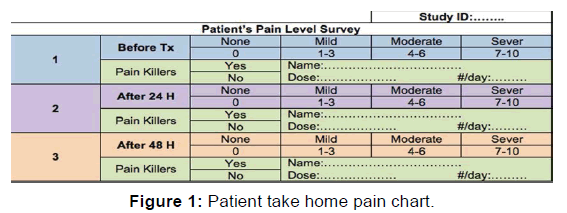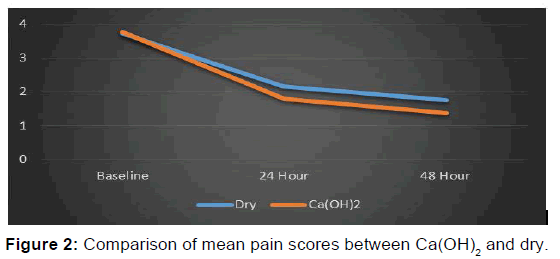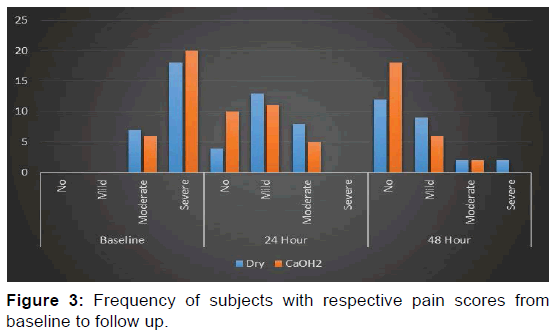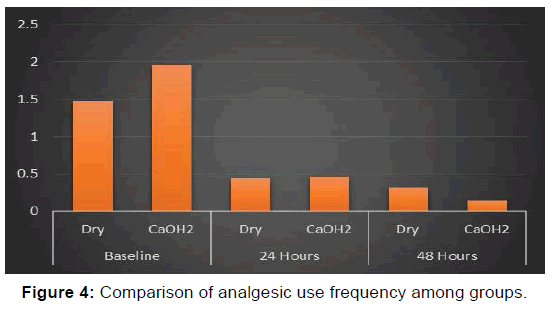Effect of Calcium Hydroxide on Post- Endodontic Pain in Female Patients with Symptomatic Irreversible Pulpitis: A Randomized Clinical Trial
Citation: Alobaid ASN, et al. Effect of Calcium Hydroxide on Post-Endodontic Pain in Female Patients with Symptomatic Irreversible Pulpitis: A Randomized Clinical Trial. Ann Med Health Sci Res. 2018;8:383-386
This open-access article is distributed under the terms of the Creative Commons Attribution Non-Commercial License (CC BY-NC) (http://creativecommons.org/licenses/by-nc/4.0/), which permits reuse, distribution and reproduction of the article, provided that the original work is properly cited and the reuse is restricted to noncommercial purposes. For commercial reuse, contact reprints@pulsus.com
Abstract
Introduction: Post-endodontic pain remains a significant challenge to the dental profession. It has been suggested that calcium hydroxide has pain-preventive properties through its anti-microbial and tissue-altering effects. The aim of this study is to evaluate the effect of intra-canal calcium hydroxide dressing on postoperative pain in female patients diagnosed with symptomatic irreversible pulpitis. Material & Methods: 51 female patients aged 20-40 years, diagnosed with symptomatic irreversible pulpitis were included. Subjects were randomly assigned to calcium hydroxide Group, 26 subjects or dry cotton pellet Group, 25 subjects. Subjects were given anesthesia, rubber dam isolation; access cavity, complete pulp extirpation, working length then canals were instrumented using hand K-files until size# 25. Ca(OH)2 was applied in (Group 1) and dry cotton pellet was put in (Group 2) then access cavities were restored. All subjects were given pain chart to fill after 24 and 48 hours. Results: The mean baseline pain level was severe (3.77 and 3.72) in Group 1 and Group 2 respectively. A significant reduction in the pain level was 1.81 & 1.38 in Group 1 and 2.16 & 1.76 in Group 2 after 24 and 48 hours. A superior pain relive (63.3%) was seen in Ca(OH)2 Group compared to control Group 52.7%. Conclusion: The emergency treatment of choice of symptomatic irreversible pulpitis is complete pulp extirpation. Ca(OH)2 reduced post-endodontic pain more than control Group but not significantly. We recommend using Ca(OH)2 since it did not have any negative influence in post-endodontic pain. Small sample size is a major limitation in our study.
Keywords
Calcium Hydroxide; Post-operative pain; Irreversible Pulpitis
Introduction
The main reason people seek emergency dental treatment is pain from teeth diagnosed with symptomatic irreversible pulpitis, which is characterized by prolonged sensitivity to cold or heat and experienced more in posterior teeth. [1] The emergency treatment of choice in such cases is to relive the pain by removing the inflamed pulp tissue and cleaning the canal system; then after that either to use intra-canal dressing material or to complete the root canal therapy and to prescribe the suitable analgesics at the end for such patients. [2]
Post-treatment pain remains a significant challenge to the profession. [3] Reports have suggested that up to 80% of people suffering from endodontic pain and continue to report pain after endodontic treatment, with pain level ranging from mild to severe. [4] Patients with moderate to severe pain before treatment were five times more likely to experience moderate to severe pain post treatment. [5]
Calcium hydroxide Ca(OH)2 an intra-canal dressing is considered as the most favorable anti-microbial agent. [6] Furthermore, because of its anti-microbial and tissue altering effects, calcium hydroxide has been reported to have pain-preventive properties. [7]
Walton et al. [7] examined the effect of Ca(OH)2 intra-canal dressing on postoperative pain in various types of pulpal and periapical pathosis with and without symptoms and found that Ca(OH)2 was not superior to leaving the canal space empty without dressing. In a different study by Asgery et al. [8] they found that using calcium enriched mixture cement after pulpotomy significantly reduced pain intensity as early as 18 hours postoperatively while in single visit root canal treatment the pain intensity was reduced after 36 hours.
In the same study, they found that calcium enriched mixture maintain the same level of pain relive while in single visit endodontic patients experienced significant pain response to percussion one week postoperatively. This study aims to evaluate the effect of intra-canal calcium hydroxide dressing on post-operative pain in female patients diagnosed with symptomatic irreversible pulpitis.
Materials and Methods
After the IRB approval of the study design with ethical clearance number # (SRC/ETH/2018-19/021), the study was conducted at College of Dentistry King Khalid University. A written consent was taken from all the participants included in the study. A total of 51 female patients aged 18-40 years old who presented to the emergency dental clinics complaining of pain in molar teeth and diagnosed with symptomatic irreversible pulpitis were included in the study. Patients with medical conditions, pregnant or breast feeding, teeth with necrotic pulp were excluded from the study. Baseline records of analgesic use, patient age, tooth type & position, and pain level (using visual analog scale) were obtained. Subjects were randomly distributed into two groups. Group 1 was assigned for calcium hydroxide (26 subjects) while group 2 was assigned for dry cotton pellet (25 subjects).
All procedures were undertaken under local anesthesia and Rubber dam isolation. A Standard infection control protocol was observed. Access cavity was prepared followed by pulp extirpation. Working length was established using @RootZX (Morita, USA) apex locator and confirmed with radiographs. Canals were irrigated with 5.25% NaOCl and instrumented with hand K-files until size# 25 to ensure complete removal of pulpal tissue and allow enough space for intracanal medication. Finally, canals were dried with paper points and freshly mixed Calcium hydroxide powder @Pulpdent (Watertown, MA, USA) with normal saline was applied in group 1 and dry cotton pellet was put in the pulp chamber of group 2 then access cavities were restored using @Plastor (Ghimas, Italy) as a temporary restoration between appointments.
All subjects were given a pain record chart [Figure 1] to fill at home after 24 and 48 hours of the initial treatment and also were reminded with a phone call. Subjects were recalled after one week to complete the root canal treatment and final coronal filling.
Data were then collected for statistical analysis. Statistical analyses were performed with SPSS Version 13 (SPSS, Chicago, IL, USA). In addition to reporting the two- sided confidence interval (CI), data were analyzed to determine whether the pain relieving effects of Ca(OH)2 were similar to those of dry cotton pellet. In the two study groups, means of pain intensity level at baseline were compared with Student’s t test, and the pain level trend after 24 and 48 hours was analyzed by repeated measures analysis of variance (ANOVA). The data of analgesics use were subjected to two-way ANOVA with treatment and analgesic use as factors. First type statistical error was considered as (P < 0.05).
Results
The mean baseline pain level was severe in both groups as 3.77 in Ca(OH)2 group and 3.72 in dry cotton group respectively. A significant reduction in the pain level was observed in both groups after 24 and 48 hours. In group 1 pain was reduced to 1.81 & 1.38 after 24 h and 48 h while in group 2 pain level was 2.16 & 1.76 as shown in Table 1. Figure 2 compared the main pain reduction in both groups at 24 h and 48 h which was not significant.
| Group | Follow up | N | Mean | SD | Wilks' Lambda | F | df | p-value | |
|---|---|---|---|---|---|---|---|---|---|
| Dry | Baseline | 25 | 3.72 | 0.458 | 0.842 | 61.387 | 2.000 | 0.000* | |
| 24 Hour | 25 | 2.16 | 0.688 | ||||||
| 48 Hour | 25 | 1.76 | 0.926 | ||||||
| Ca(OH)2 | Baseline | 26 | 3.77 | 0.430 | 0.087 | 125.829 | 2.000 | 0.000* | |
| 24 Hour | 26 | 1.81 | 0.749 | ||||||
| 48 Hour | 26 | 1.38 | 0.637 |
*Statistically significant at 5% level of significance
Table 1: Comparison of pain scores from baseline to 24 hour and 48 hour follow up using Repeated Measures ANOVA.
During follow up visits, the mean difference in pain score was 1.96 & 1.56 comparing baseline with 24 h in Ca(OH)2 and Dry cotton respectively and was 2.39 & 1.96 comparing baselines with 48 h in both groups as shown in Table 2. The frequency of subjects among pain levels was shown in Figure 3 where most of the subjects were in severe pain level at the baseline records while after 24 h subjects were mainly in mild to moderate pain level and mostly free of pain after 48 h.
| Pain Score | |||
|---|---|---|---|
| Mean Difference | Percentage reduction | p-value | |
| Baseline to 24 Hour | 1.560 | 41.9 | 0.000* |
| 24 Hour to 48 Hour | 0.400 | 10.8 | 0.022* |
| Baseline to 48 Hour | 1.960 | 52.7 | 0.000* |
| Baseline to 24 Hour | 1.962 | 52.0 | 0.000* |
| 24 Hour to 48 Hour | 0.423 | 11.2 | 0.003* |
| Baseline to 48 Hour | 2.385 | 63.3 | 0.000* |
*Significant at 5% level of Significance. LSD test
Table 2: Reduction in pain scores during follow up visits.
A significant reduction of analgesic use was observed in follow up visits in all groups with no significant difference among groups as shown in Figure 4. Although Ca(OH)2 showed better results in pain score reduction after 24 h and 48 h compared to dry cotton, that was not statistically significant. Overall, there were no flare-ups during follow up visits and the clinical procedure itself was the most important factor in pain score reduction.
Discussion
A number of treatment options are available for painful tooth with established irreversible pulpitis, including pulpotomy, pulpectomy or RCT while in fact using painkillers alone or tooth extraction are the extreme options. Although RCT is the treatment of choice, for some reasons, extraction may be a more attractive treatment option. In some instances patients use self-prescribed analgesics to delay tooth extraction. [8,9] We hypothesized that pulpectomy treatment using Ca(OH)2 dressing might be able to play an important role in such cases. This study showed a significant reduction in pain level within the first 24H after providing pulpectomy treatment in molar teeth with symptomatic irreversible pulpitis. These results agree with the consensus that pulpectomy or pulpotomy is probably the most important factor in reducing post-treatment pain, regardless of other variables. [10,11]
Population-based research consistently demonstrates greater pain prevalence among women relative to men. The literature also suggests clear difference between men and women in pain response and analysis which is more common in women. It suggests that multiple biological and psychosocial processes are common contributing factors to these differences. [12] Therefore only female patients were accepted to participate in our study to control the gender variable effects on response to pain, sensitivity and risk of pain. Many studies talked about early life exposure to pain and stress effect on pain process in relation to gender and age considering men and older patients are more tolerant to pain. [12,13] Therefore, age was limited in our study to young adult patients only (18-40 years) to eliminate age related confounding factors.
Pain perception is highly subjective and modulated by many factors thus; it could be influenced by factors other than the experimental procedures with difficult pain assessment and more opportunities for error. Pain scales are based on the theory that pain intensity is continuous, without jumps or intervals. [14] VAS simplifies pain rating by allowing patients to quantify the extent of their pain by rating it from 0 to 10 in four grades. Preoperative (baseline) pain is related to inflammatory reactions initiated by bacterial invasion, and lasts from several minutes to several days. [15] the baseline pain level means were severe at 3.77 in group 1 and 3.72 in group 2. These pain scores suggest that these patients with irreversible pulpitis might have opted for tooth extraction. To achieve meaningful comparisons between treatment effectiveness in providing pain relief, the baseline recordings in both groups should be similar. This condition was met in this trial, no significant difference being present in the baseline means of pain level.
The antimicrobial action of Ca(OH)2 is related to hydroxyl ions release in aqueous solutions. [16] It is highly oxidant free radicals with extreme reactivity with biomolecules. [17] The antimicrobial effect of hydroxyl ions is through damaging cytoplasmic membrane, damaging the DNA, or protein denaturation. [18] As long as high pH is maintained by free hydroxyl ions, Ca(OH)2 will exert its antimicrobial effect. [18] Multiple in vivo studies [19-21] reported excellent antimicrobial effect on different endodontic microorganisms with fewer number of bacteria after root canal dressing with Ca(OH)2 compared to other treatment modalities. Shuping et al. [22] showed that about 93% of canals are bacteria free after one week dressing with Ca(OH)2
This study showed that the mean postoperative pain level scores significantly decreased in both groups following treatment; however, no significant differences between Ca(OH)2 and dry cotton group was seen. Analgesics use was significantly reduced in both groups at 24 h and 48 h after treatment. Patients in both groups were completely asymptomatic after 1 week. The main study limitation was the small sample size. This was due to too specific inclusion criteria which made it difficult to collect subjects in short time limits. Also, most of the patients did not attend their follow up visits which might be due to absence of pain after the first visit and lack of motivation to complete dental treatment.
Conclusion
Since calcium hydroxide is an excellent antimicrobial agent and with pain preventive properties, the study aimed to evaluate its effect in reducing post-endodontic pain in symptomatic female subjects. Despite the small sample of this study, Ca(OH)2 reduced post-endodontic pain more than control group however it was not significant. Therefore we recommend using Ca(OH)2 during emergency endodontic treatment to help reducing pain and present bacterial infection and rendering further bacterial invasion. Finally, the emergency treatment of choice of symptomatic irreversible pulpitis is complete pulp extirpation.
Conflict of Interest
The authors disclose that they have no conflicts of interest
REFERENCES
- Wayman BE, Patten JA, Dazey SE. Relative frequency of teeth needing endodontic treatment in 3350 consecutive endodontic patients. J Endod 1994;20:399-401.
- Nusstein JM, Beck M. Comparison of pre-operative pain and medication use in emergency patients presenting with irreversible pulpitis or teeth with necrotic pulps. Oral Surg Oral Med Oral Pathol Oral Radiol Endod 2003;96:207-214.
- Memon NA, Memon MR, Ali F, Noor-ul-An E. Assessment of the Interappointment pain by using two different intracanal medicaments. Pak Oral Dent J 2013;33:145-150.
- Martin H, Cunningham WT. An evaluation of postoperative pain incidence following endosonic and conventional root canal therapy. Oral Surg Oral Med Oral Pathol 2003;54:74-76.
- Holstein A, Hargreaves KM, Neiderman R. Evaluation of NSAIDs for treating post endodontic pain. Endod Topics 2002;3:3-13.
- Ghoddusi J, Javidi M, Zarrabi MH, Bagheri H. Flare-ups incidence and severity after using calcium hydroxide as intracanal dressing. N Y State Dent J 2006;72:24-28.
- Walton RE, Holton IF Jr, Michelich R. Calcium hydroxide as an intracanal medication: Effect on posttreatment pain. J Endod 2003;29:627-629.
- Asgary S, Eghbal M. The effect of pulpotomy using Calcium-Enriched Mixture cement versus one-visit root canal therapy on postoperative pain relief in irreversible pulpitis: a randomized clinical trial. Odontology 2010;98:126-133.
- Asgary S, Ehsani S. Permanent molar pulpotomy with new endodontic cement: a case series. J Conserv Dent 2009;12:31-36.
- Hasselgren G, Reit C. Emergency pulpotomy: pain relieving effect with and without the use of sedative dressings. J Endod 1989;15:254-256.
- Harrison JW, Gaumgartner JC, Svec TA. Incidence of pain associate with clinical factors during and after root canal therapy. Part 1. Interappointment pain. J Endod 1983;9:384-387.
- Bartley EJ, Fillingim RB. Sex differences in pain: a brief review of clinical and experimental findings. British Journal of Anaesthesia 2013;111:52-58.
- Liddell A, Locker D. Gender and age differences in attitudes to dental pain and dental control. Community Dent Oral Epidemiol. 1997;25:314-318.
- Seymour RA, Simpson JM, Charlton JE, Phillips ME. An evaluation of length and end-phrase of visual analogue scales in dental pain. Pain 1985;21:177-185
- Clem WH. Posttreatment endodontic pain. J Am Dent Assoc 1970;81:1166-1170.
- Siqueira JF. Strategies to treat infected root canals. Journal of California Dental Association 2001;29:825-837.
- Mohammadi Z, Dummer MH. Properties and applications of calcium hydroxide in endodontics and dental traumatology. Int. Endod. J, 2011;44:697-730.
- Siqueira JF, Lopes HP. Mechanisms of antimicrobial activity of calcium hydroxide: a critical review. International Endodontic Journal 1999;32:361-369.
- Bystro¨m A, Claesson R, Sundqvist G. The antibacterial effect of camphorated paramonochlorophenol, camphorated phenol, and calcium hydroxide in the treatment of infected root canals. Endodontics & Dental Traumatology 1985;1:170-175.
- Han GY, Park SH, Yoon TC. Antimicrobial activity of Ca(OH)2 containing pastes with Enterococcus faecalis in vitro. Journal of Endodontics 2001;27:328-332.
- Sjo¨gren U, Figdor D, Spangberg L, Sundqvist G. The antimicrobial effect of calcium hydroxide as a short-term intracanal dressing. International Endodontic Journal 1991;24:119-125.
- Shuping GB, Ørstavik D, Sigurdsson A. Reduction of intracanal bacteria using nickel-titanium rotary instrumentation and various medications. Journal of Endodontics 2000;26:751-755.








 The Annals of Medical and Health Sciences Research is a monthly multidisciplinary medical journal.
The Annals of Medical and Health Sciences Research is a monthly multidisciplinary medical journal.